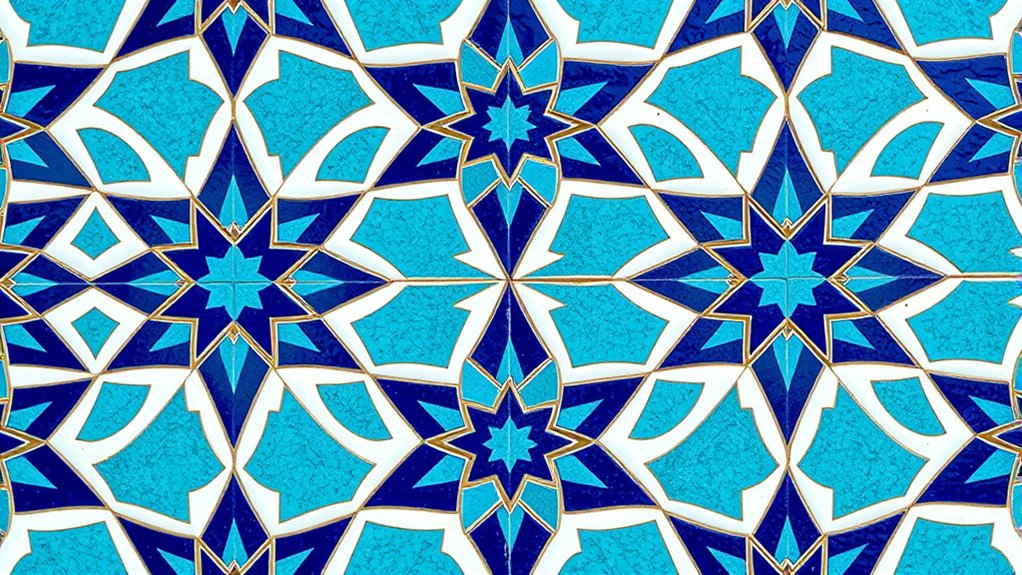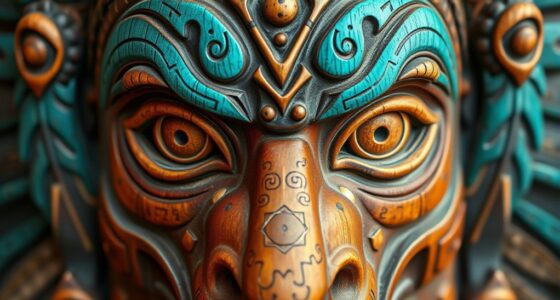Deciphering the geometry of Islamic tile art reveals a masterful use of repetitive shapes, symmetry, and tessellations that extend infinitely, symbolizing divine harmony and the universe’s order. By recognizing how simple geometric forms like squares, triangles, and stars interlock with precise symmetry, you uncover how these designs reflect both artistic beauty and spiritual meaning. Continuing your exploration uncovers deeper connections between mathematics, spirituality, and artistic mastery embedded in these timeless patterns.
Key Takeaways
- Islamic tile art employs geometric tessellations using simple shapes like squares, triangles, and stars to create intricate, seamless patterns.
- Symmetry—reflective, rotational, and translational—ensures balance, harmony, and visual rhythm in tile designs.
- Patterns symbolize divine infinity and universal order, reflecting spiritual concepts through precise mathematical principles.
- Artistic techniques, such as glazed tiles and meticulous geometric construction, enhance both aesthetic and symbolic depth.
- The interplay of art and mathematics reveals a visual language that embodies spiritual harmony and human ingenuity.

Islamic tile art captivates viewers with its intricate geometric patterns that seamlessly blend mathematics and spirituality. These designs are more than just decoration; they embody a deep understanding of symmetry and structure, reflecting the universe’s order and divine harmony. When you observe these patterns, you’ll notice how tile pattern symmetry plays a vital role in their creation. Symmetry ensures that each pattern maintains balance and harmony, often achieved through reflective, rotational, or translational symmetry. This deliberate repetition isn’t accidental; it’s a reflection of the Islamic belief in unity and infinity, where patterns extend seamlessly without beginning or end. As you study these designs, you’ll see how symmetry creates a sense of rhythm and coherence, leading your eye effortlessly across the surface. Additionally, the use of natural materials like glazed tiles enhances the visual depth and spiritual resonance of the patterns. The foundation of many Islamic tile patterns is geometric tessellations—repeating shapes that fit together without gaps or overlaps. These tessellations are carefully constructed using a limited set of geometric principles, such as the use of polygons like squares, triangles, or stars. You might notice how the tessellations form complex, mesmerizing motifs that seem to interlock perfectly, creating an illusion of endless continuity. This technique not only demonstrates mathematical precision but also embodies spiritual concepts of eternity and the infinite nature of creation. The mastery in designing these tessellations lies in understanding how simple shapes can generate elaborate, cohesive patterns, revealing the sophisticated geometric knowledge that Islamic artisans possessed. When you explore more deeply, you’ll see how each tile pattern is meticulously crafted, often involving a combination of symmetry operations and tessellations. These patterns are not randomly assembled but are based on a core geometric logic that guides their development. By analyzing the symmetry in each tile, you gain insight into the underlying mathematical principles, such as the use of rotational symmetry to create star-like motifs or reflectional symmetry to produce mirror images. The complexity of these patterns might seem overwhelming at first, but once you grasp the underlying principles, you’ll appreciate the elegance and precision involved. These geometric arrangements serve both aesthetic and symbolic purposes, illustrating divine order and the unchanging laws of nature. In essence, deciphering the geometry of Islamic tile art reveals a sophisticated interplay between art and science. You’re not just observing decorative motifs—you’re witnessing a visual language rooted in mathematical concepts like tile pattern symmetry and geometric tessellations. This harmony between mathematics and spirituality underscores the profound cultural and religious significance of Islamic tile design, making it a timeless proof to human ingenuity and divine inspiration.
Frequently Asked Questions
How Did Islamic Tile Art Influence Contemporary Design?
Islamic tile art influences contemporary design through intricate patterns and symmetry. You’ll notice how Islamic tessellation techniques inspire modern decorative motifs, creating visually mesmerizing surfaces. These timeless geometric principles are incorporated into architecture, fashion, and interior design, adding a sense of harmony and complexity. By adopting these techniques, designers like you blend tradition with innovation, making spaces and objects more engaging and culturally rich.
What Materials Are Traditionally Used in Islamic Tile Manufacturing?
You’ll find that traditional Islamic tiles use durable clay composition, which forms the base for their intricate designs. Ceramic glazes are applied to add vibrant colors and a glossy finish, enhancing both beauty and durability. These materials work together to create stunning, long-lasting surfaces. The careful selection of clay and the mastery of ceramic glazes reflect the artistry and technical skill that define Islamic tile manufacturing.
Are There Regional Variations in Islamic Geometric Patterns?
You’ll notice regional styles greatly influence Islamic geometric patterns, creating impressive pattern diversity across different areas. In regions like Persia, patterns often feature intricate, flowing designs, while Ottoman tiles emphasize bold, symmetrical shapes. These variations reflect local cultural influences, available materials, and historical contexts. By exploring these differences, you’ll see how each region uniquely interprets geometric art, enriching the overall tapestry of Islamic tile decoration.
How Do Islamic Artists Balance Symbolism and Aesthetics?
Imagine a delicate mosaic where each tile whispers symbolic representation, yet creates a mesmerizing pattern. You see how Islamic artists balance these elements by blending intricate geometry with visual harmony, ensuring that symbolism enhances beauty without overpowering. They craft designs that invite contemplation, where aesthetic harmony and symbolic meaning coexist seamlessly. This careful interplay transforms simple tiles into profound expressions of spirituality, demonstrating that beauty and deeper significance can beautifully coexist in art.
What Tools Are Used to Create Intricate Tile Geometry?
To create intricate tile geometry, you use a variety of tools and techniques. You might employ compass and straightedge for precise pattern analysis, helping you develop complex designs. Modern artists often incorporate computer-aided design (CAD) software to refine their patterns. Traditional techniques include hand-drawing grids and geometric constructions. These tools enable you to analyze and execute detailed, symmetrical patterns that reflect the artistry and mathematical precision of Islamic tile art.
Conclusion
Now that you’ve revealed the secrets of Islamic tile geometry, you hold the key to a universe of infinite patterns and divine precision. Every tile isn’t just art—it’s a gateway to the cosmos itself, where math and spirituality collide in breathtaking harmony. Your newfound understanding transforms these mesmerizing designs from mere decoration into the very fabric of eternity. Prepare to see the world through a lens so intricate, it’ll forever change how you perceive beauty and infinity.










